- At a Glance: Comparing Homebase vs When I Work
- Core Feature Comparison: What You Really Get with Homebase and When I Work
- The Best Industries for When I Work vs Homebase
- Which One’s Best for Your Small Business?
- Learn More About Homebase and When I Work
- Final Thoughts: The Smarter Pick for Your Business
Last Updated on November 4, 2025 by Ewen Finser
When you’re running a small team, scheduling can turn into a full-time job. I’ve managed hourly employees in the past, and I know the drill: someone’s always calling in sick, someone else forgets their shift, and before you know it, you’re texting three people just to find a Friday closer.
That’s when I turned to scheduling apps. First up was When I Work, which has a clean interface and solid reputation. It’s good enough to get the job done. But after trying out Homebase, I realized I’d been settling. One tool made me feel like I was constantly putting out fires. The other? Like I was actually in control.
So, if you’re deciding between Homebase and When I Work, here’s everything you need to know, with zero fluff, a few strong opinions, and some real-world clarity.
At a Glance: Comparing Homebase vs When I Work
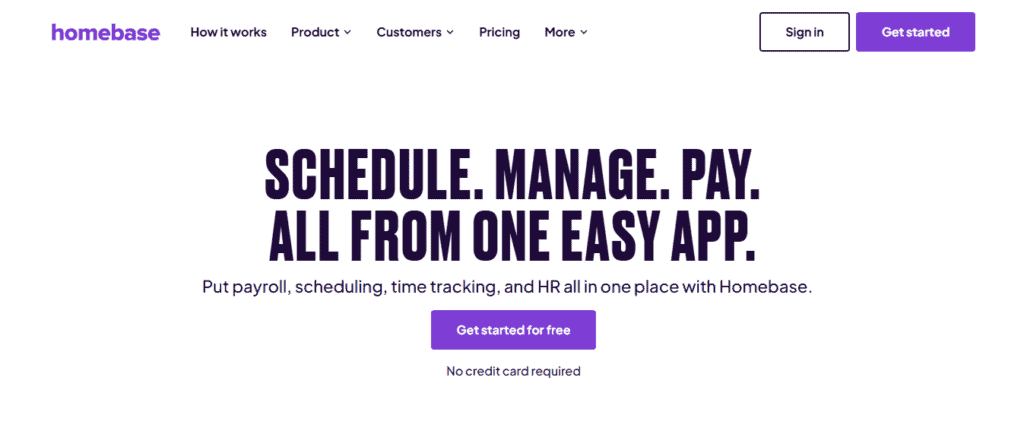
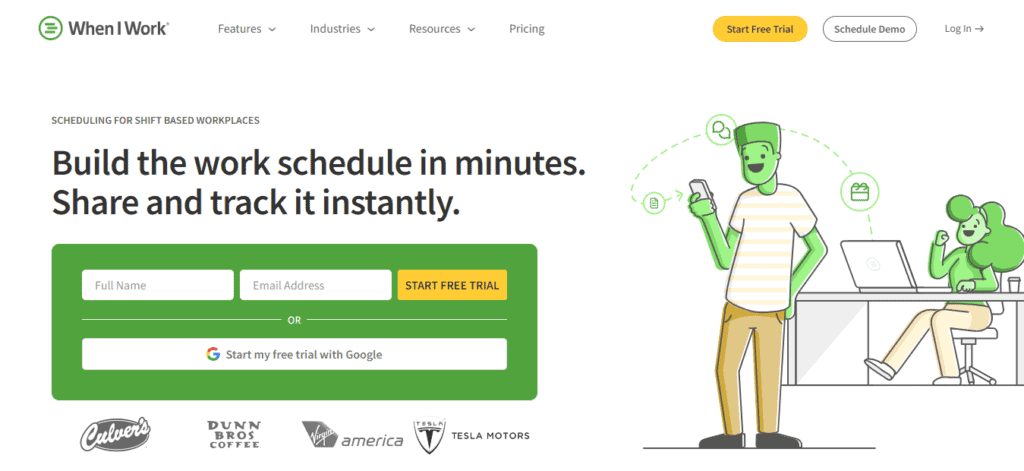
If you just want the TL;DR, here’s how the two stack up side by side:
Feature | Homebase | When I Work |
Free Plan | Yes (for 1 location and up to 10 employees) | No |
Scheduling | Drag-and-drop, templates | Basic shift tools |
Time Tracking | Included with scheduling | Included with plan |
Payroll | Built-in (add-on) | Requires Gusto or other |
Team Messaging | Built-in and easy to use | Built-in with basic chat |
HR & Compliance | Alerts, docs, and advisors | Not included |
Ease of Use | ★★★★★ | ★★★ |
Best For | Hourly teams and all industries | Restaurants and field/remote teams |
Free trial | Yes, 14 days | Yes, 14 days |
Starting Price | $0–$120 per location per month (unlimited employees) | $2.50–$5 per user per month |
Core Feature Comparison: What You Really Get with Homebase and When I Work
These are the features that shape your day-to-day, because scheduling apps live or die by how much chaos they prevent.
Here’s how Homebase and When I Work stack up where it actually counts:
Scheduling
Both apps offer basic scheduling functionality, but if you’re managing any sort of complexity, from rotating shifts and variable staffing levels to team members with limited availability, you’ll feel the difference fast.
- Homebase
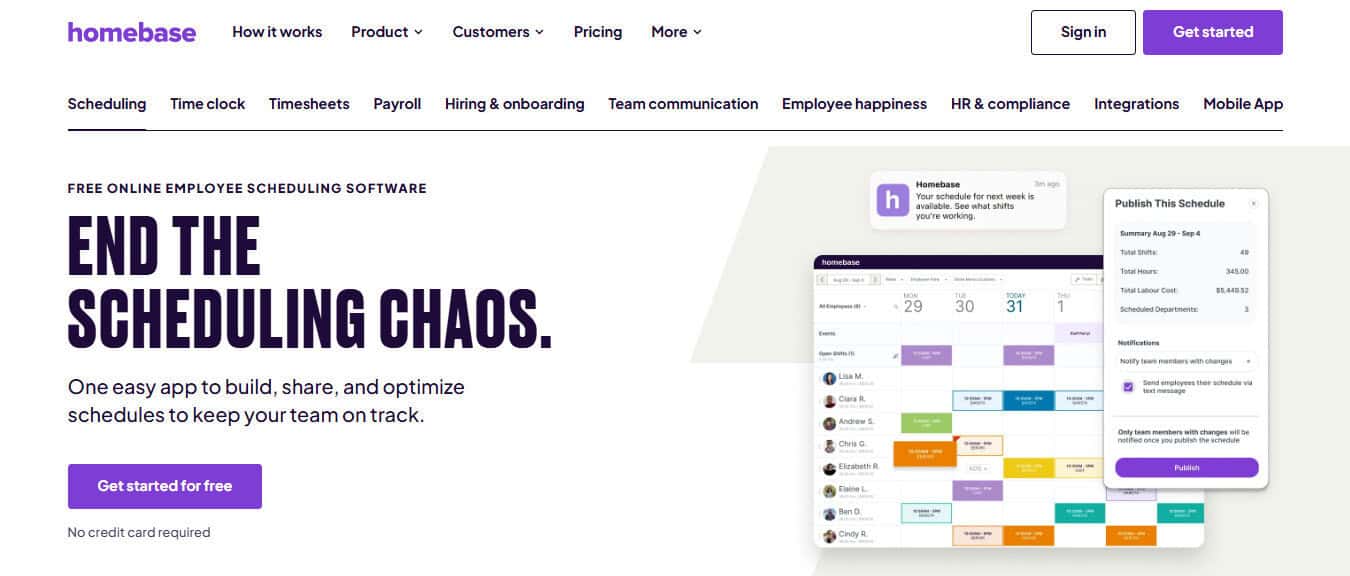
Homebase makes scheduling feel like a modern calendar tool. You can drag and drop shifts, reuse templates, and build schedules around employee availability and time-off requests. It auto-detects scheduling conflicts and alerts you if someone’s going into overtime or exceeding hour limits. You also get forecasting tools that help you plan schedules based on expected labor needs and sales trends (which is great for retail and restaurants).
The auto-scheduling feature is a sleeper hit. It saves managers hours every week by populating shifts with the best-fit employees. Add labor cost calculations right in the schedule, and you can see how payroll will be impacted before you publish.
A busy bakery that doubles staff on weekends can use Homebase to forecast labor costs, auto-assign shifts based on availability, and adjust staffing levels for special events, all in one place.
- When I Work
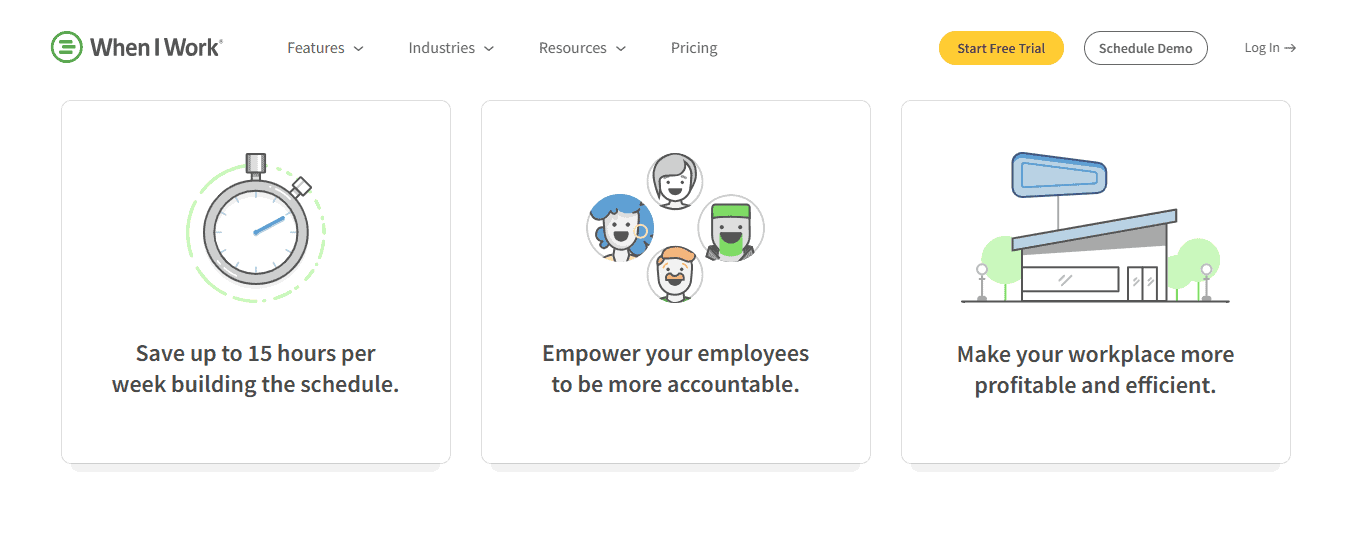
When I Work gets the job done for basic shift planning. You can assign shifts, copy them week-to-week, and manage time-off requests. It’s definitely functional, but lacks deeper automation and built-in labor forecasting. If your business is growing, or you have frequent shift changes, it may start to feel a little too manual.
Time Tracking & Timesheets
Punch clocks have gone digital, and the right time tracking tool makes payroll faster, fraud harder, and errors easier to catch.
- Homebase
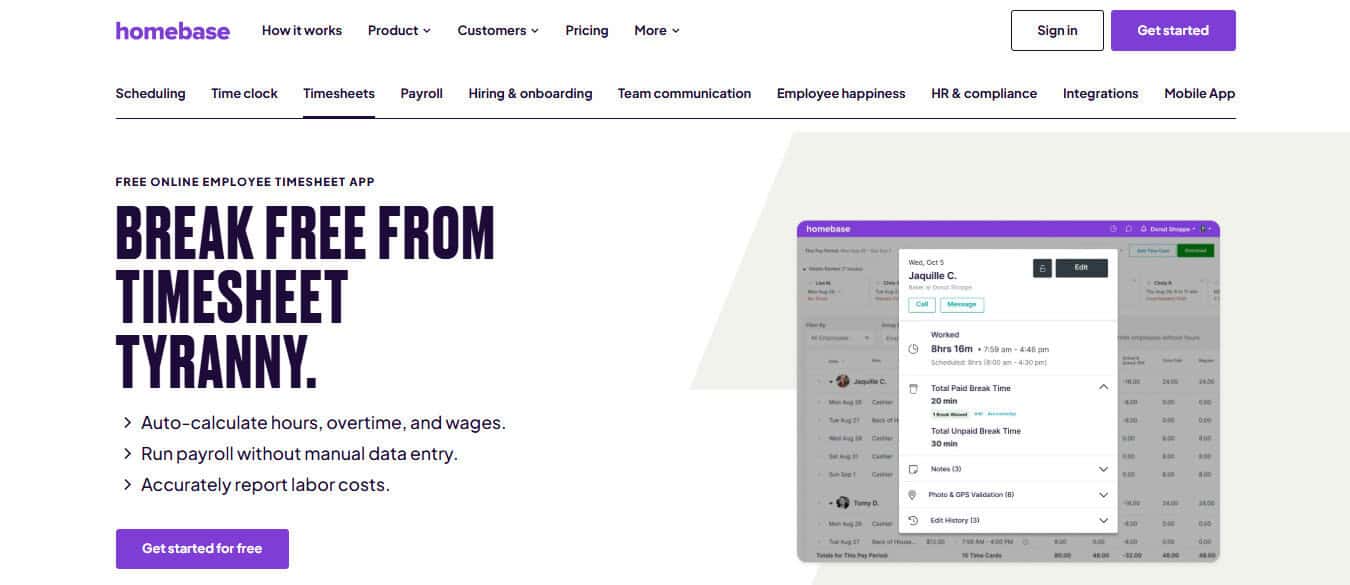
Homebase offers GPS-enabled mobile clock-ins, geofencing (so no clocking in from the parking lot), and physical tablet time clocks. Employees can view their hours and submit edits or shift notes if needed. Managers get auto-generated timesheets that flag anything unusual: missing punches, overtime, missed breaks. This drastically reduces time spent on manual review.
You can also restrict early clock-ins, set break enforcement rules, and require photo verification to prevent buddy punching. All time data syncs with Homebase Payroll or your chosen provider, and that’s a major win for accuracy.
For example, a cleaning company with teams clocking in from different job sites can use Homebase’s GPS and geofencing to ensure hours are logged from the actual location, not a couch or café five miles away.
- When I Work

When I Work offers time tracking. The tool covers basic needs, like clock-ins, shift notes, and mobile access, but it doesn’t offer the same level of granularity or compliance controls. For example, there’s no automatic break enforcement or robust fraud prevention features like selfie clock-ins.
Payroll and HR Compliance
Scheduling is just one side of managing a team; compliance, taxes, and onboarding are the other (less glamorous) half.
- Homebase
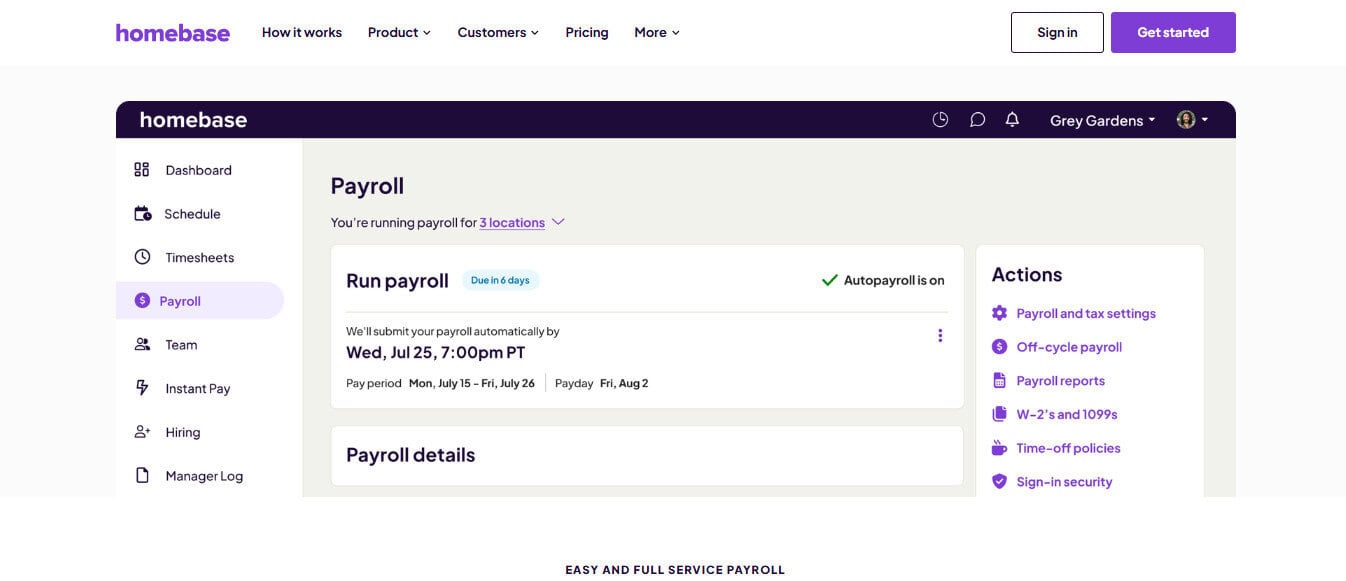
Homebase handles that side too. It includes built-in payroll (as an optional add-on), complete with tax filing, W-2 and 1099 support, and direct deposit. New employees can complete digital onboarding forms and sign policy docs in the app. Higher-tier plans include access to certified HR advisors, customizable policy libraries, and compliance alerts when labor laws change in your state.
For small businesses without dedicated HR staff, this is huge. It’s rare to find these features integrated into scheduling software, let alone with this level of polish.
A salon onboarding seasonal stylists can use Homebase to collect tax forms, set up payroll, and share the employee handbook, all before the first shift.
What really stands out about Homebase Payroll is how everything works together automatically. Scheduling, time tracking, and payroll all sync in real time — no exporting timesheets, no double entry, and no late-night prep before payday. It’s built specifically for hourly teams, automatically handling breaks, tips, and overtime while catching tax or compliance mistakes before they turn into real problems.
The setup process is quick and guided by real people, so switching over doesn’t require an accountant or IT support. Once everything’s running, payroll becomes one less thing to think about — smooth, accurate, and reliable every time. For small business owners who’ve spent hours juggling multiple tools, that kind of automation makes a big difference.
- When I Work
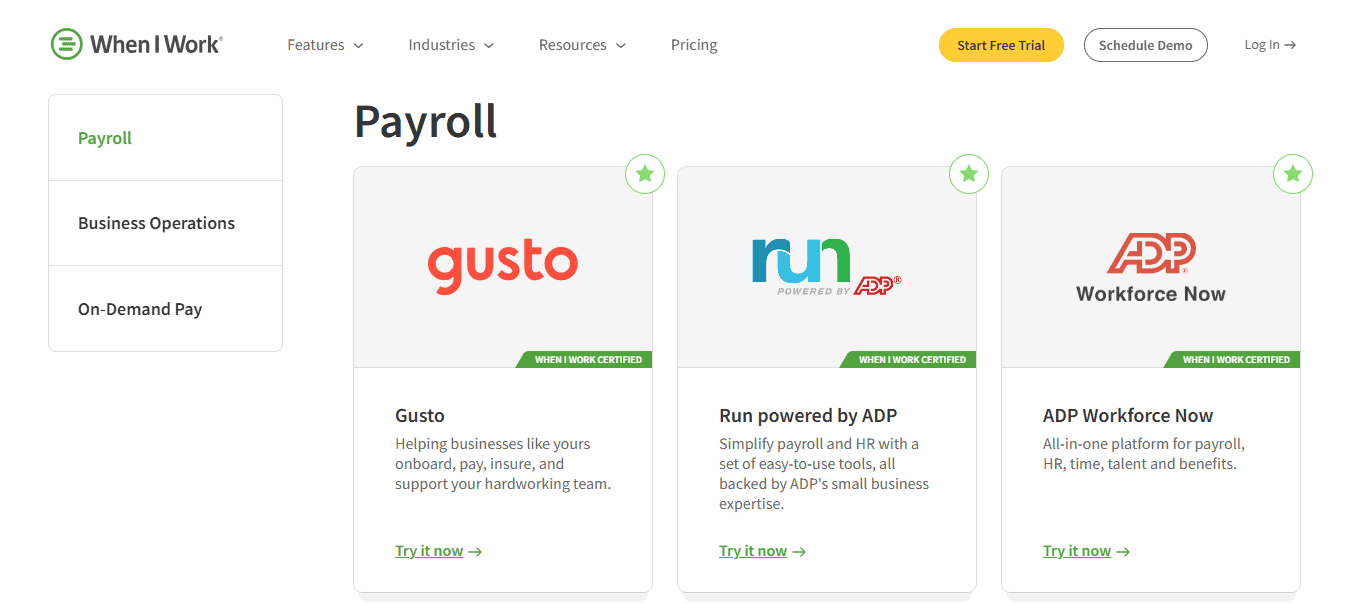
When I Work skips these responsibilities altogether. There’s no payroll built in, and no HR toolkit. You’ll need to integrate it with a provider like Gusto or QuickBooks Payroll, and manage all compliance documentation manually or through a separate HR platform.
Team Messaging & Shift Communication
You could have the best shift plan in the world, but if nobody sees it (or reads it), it might as well be scribbled on a napkin.
- Homebase
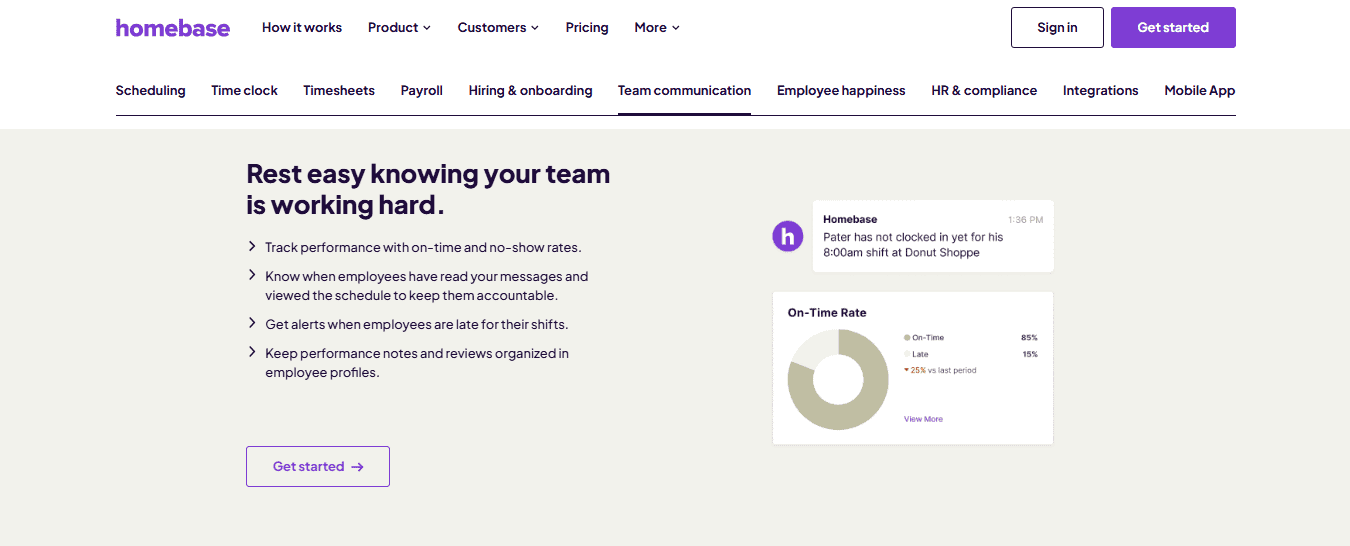
Homebase understands this. Messaging is fully integrated and threaded by topic or team. You can send announcements, schedule alerts, and direct messages to specific employees. Everyone gets push notifications when shifts change or when important updates are posted. You can even attach documents or links to policies, so there’s no confusion about expectations.
Shift reminders are automated, and late clock-ins can trigger alerts. That kind of proactive communication reduces no-shows and confusion, especially for teams with mixed experience levels or new hires.
For example, a retail store manager can send a last-minute shift update to all closers, include a PDF of the sales floor layout for the new promo, and confirm read receipts, all without leaving Homebase.
- When I Work
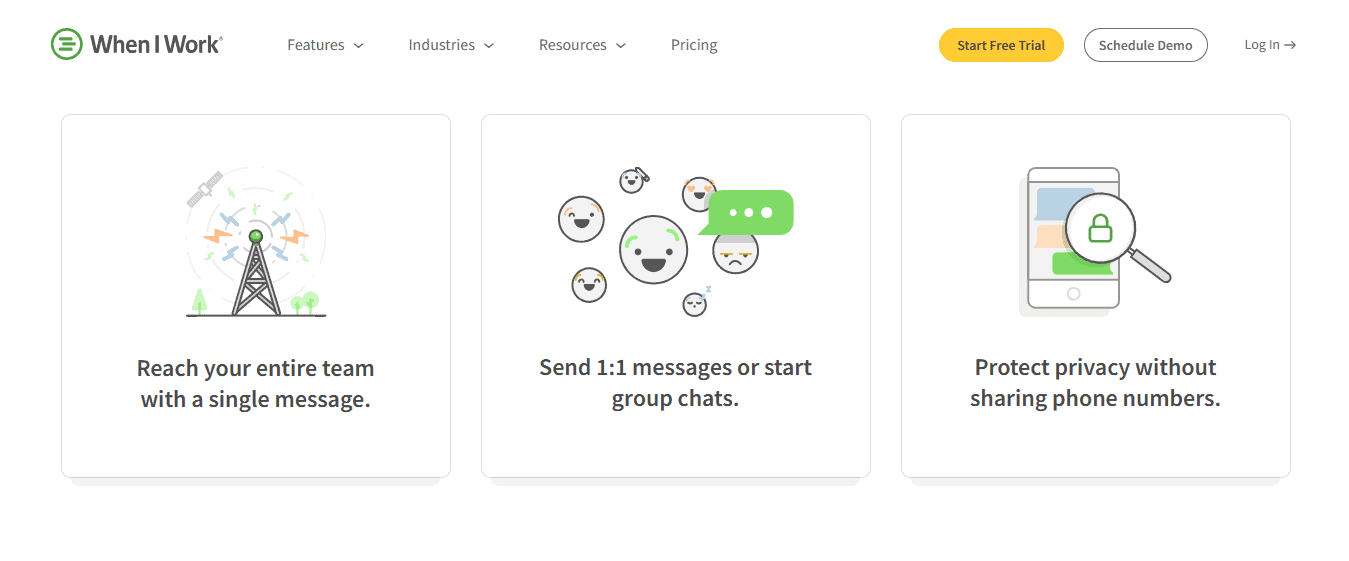
When I Work has a more basic chat system. It works for shift coverage and quick team messages, but lacks file-sharing, tagging, or robust notification settings. It’s fine if your team is small and tight-knit, but it may feel limiting as your team scales.
Integrations
If you’re already juggling a few platforms for payroll, POS, and accounting, choosing a scheduling tool that plugs in can save you hours of hassle.
- Homebase
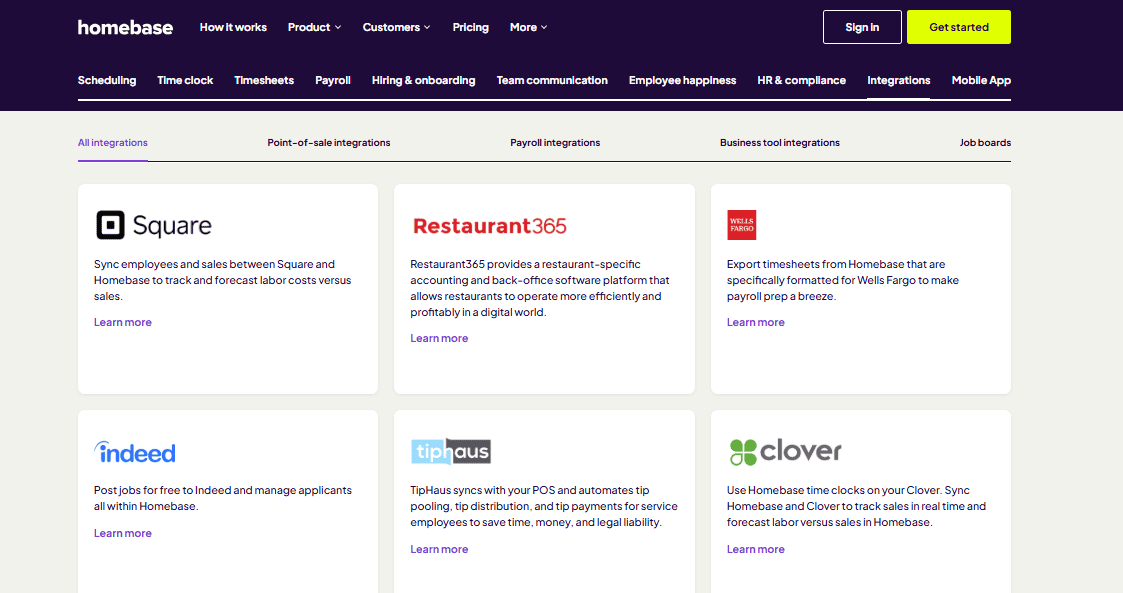
Homebase integrates with a wide range of tools including:
- Payroll: Gusto, QuickBooks, ADP (or use Homebase Payroll directly)
- POS systems: Square, Clover, Toast
- Hiring platforms: Indeed, ZipRecruiter, Glassdoor, Google, and Craigslist
These integrations are available even on lower-tier paid plans, which means you’re not forced into an expensive upgrade just to connect your systems. Setup is straightforward and well-documented.
- When I Work
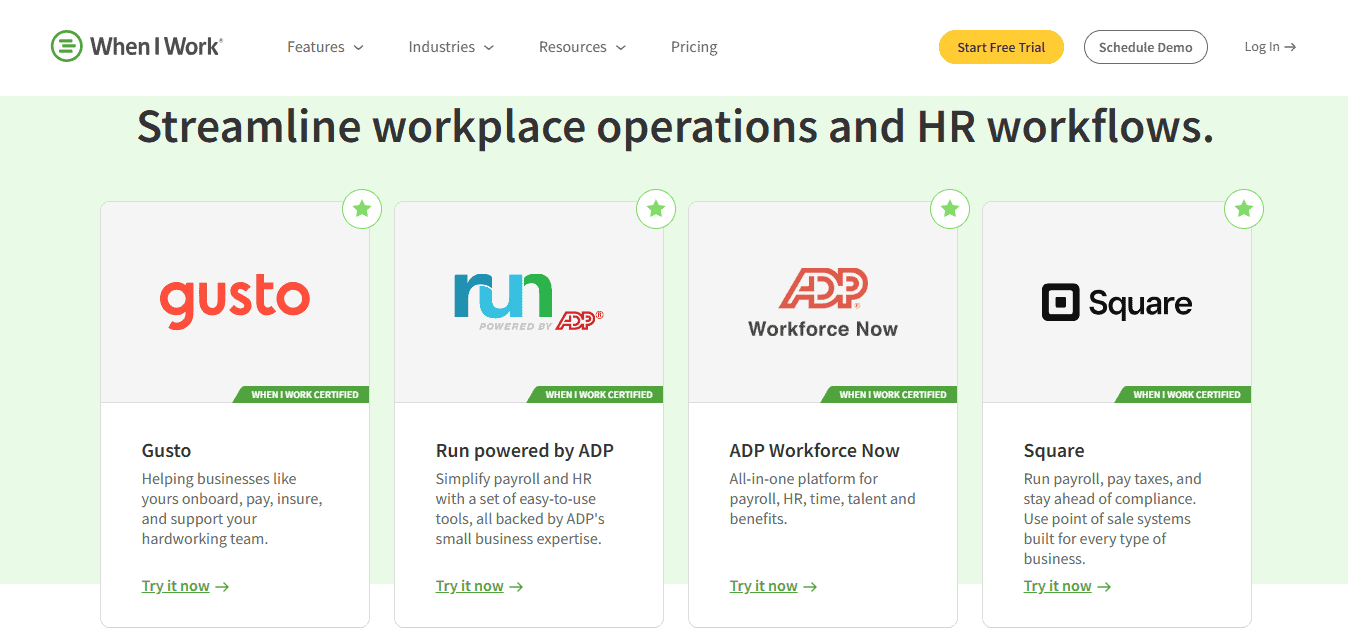
When I Work offers a solid set of integrations, too, including:
- Payroll: Gusto, QuickBooks, ADP, Paychex
- Other: Zapier (for custom workflows), GoCo, and People
If seamless integrations are part of your day-to-day workflow, Homebase offers more flexibility out of the box, especially for scrappy teams that don’t want to duct-tape everything together.
Pricing & Scalability
Let’s be real: even the best tool won’t fly if it wrecks your budget.
- Homebase
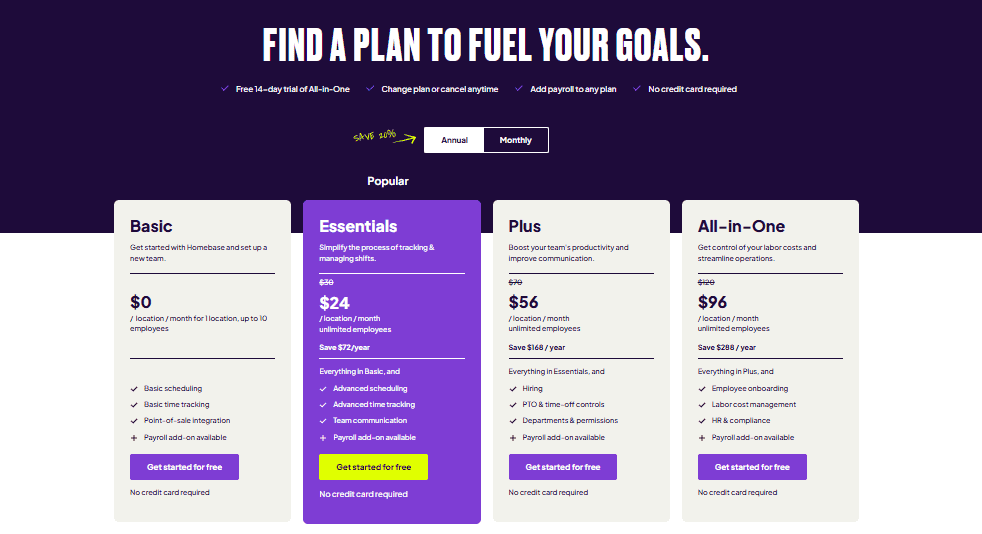
Homebase offers a genuinely free plan for one location and up to 10 employees. That includes scheduling, time tracking, messaging, and hiring tools.
Paid plans start at $30.00 per location per month for unlimited employees (when not discounted), and include advanced scheduling, performance tracking, and integrations. Payroll is a separate add-on, starting around $39 per month plus $6 per employee. It’s comparable to Gusto but more tightly integrated.
And since pricing is per location, not per user, Homebase scales much better for growing teams.
- When I Work
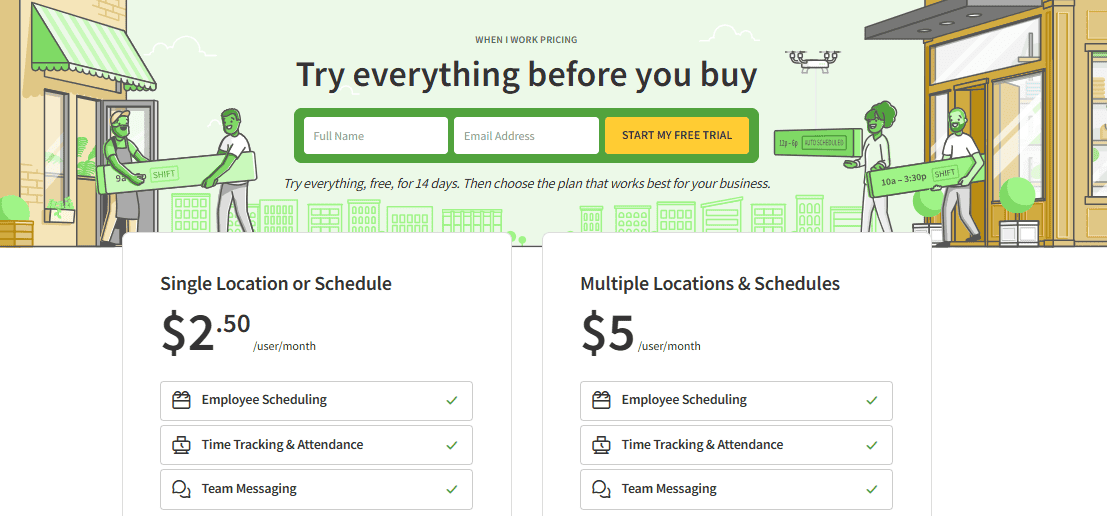
When I Work doesn’t offer a free plan. So if you need basic time tracking, shift bidding, or team communication, pricing starts at $2.50 per user per month, which adds up fast if you have 10–20 (or more) employees.
And if you want custom reporting, toggling between time zones, and multiple shift coverage views, the price doubles.
The Best Industries for When I Work vs Homebase
While both apps can serve a variety of small businesses, each has carved out a niche where it really shines.
Homebase is best for:
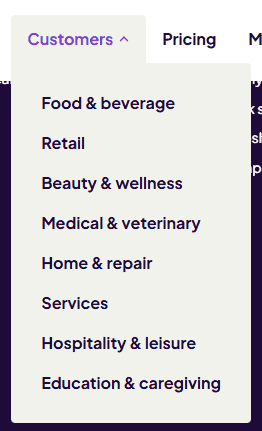
- Retail teams, thanks to labor forecasting, sales-based scheduling, and multi-location support.
- Salons and spas, where built-in onboarding, document storage, and time tracking are essential.
- Cleaning and home services, especially with GPS-enabled clock-ins and shift reminders that work in the field.
When I Work is ideal for:
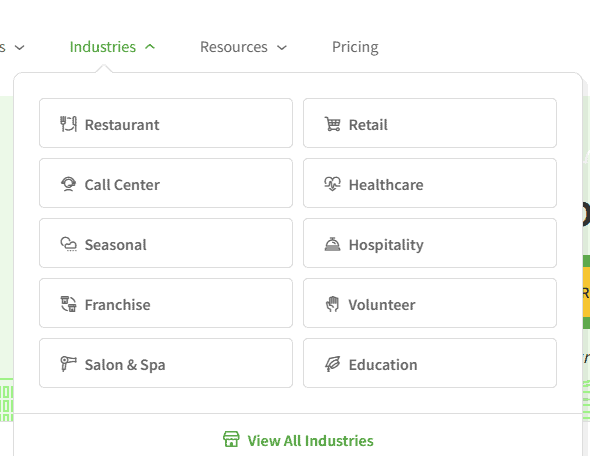
- Restaurants, with tools like job site tracking, simple schedule repeats, and shift bids for open coverage.
- Construction crews or field teams, where mobile-first shift access and minimal complexity are more important than HR tools.
Both tools can work in hospitality, healthcare, and logistics, but if you need payroll and HR in the same app, Homebase is the safer bet.
Which One’s Best for Your Small Business?
Here’s the bottom line: it depends on how many moving parts you’re juggling.
Choose Homebase if:
- You need scheduling, payroll, messaging, and HR tools in one place
- You’re managing multiple locations or rotating shifts
- You want to save time instead of creating more admin
Choose When I Work if:
- You’re in a niche like restaurants and only need basic scheduling
- You already have separate tools for payroll and HR
- You want a lightweight system and don’t mind integrations
Learn More About Homebase and When I Work
Here are a few common questions business owners ask when comparing the two:
1. Can I use Homebase for multiple locations?
Yes, even on paid plans, Homebase lets you manage separate locations, roles, and teams without needing separate logins.
2. Does When I Work offer payroll services?
No. You’ll need to connect a third-party provider like Gusto or QuickBooks Payroll.
3. Which scheduling app is easier for employees to use?
Homebase tends to be more intuitive for all skill levels. The mobile app is well-rated and easy to navigate.
4. Are When I Work and Homebase mobile-friendly?
Yes, both offer iOS and Android apps, but Homebase includes more functionality in its mobile version, like document storage and onboarding.
5. Is Homebase and When I Work good for seasonal or temp teams?
Homebase is particularly strong here. You can quickly onboard new team members with digital forms and remove them when the season’s over. It’s easy to scale your team up or down without messing up your billing plan. When I Work can handle temp teams too, but onboarding and offboarding require more manual steps.
Final Thoughts: The Smarter Pick for Your Business
Homebase and When I Work have earned their stripes, but for most small teams juggling schedules, timesheets, and last-minute chaos, Homebase just covers more ground.
It’s not only about shift planning; it’s about saving time, reducing stress, and having one hub where everything just works. From team messaging to payroll to real HR support, Homebase takes the admin off your plate so you can actually focus on running your business.
If you’re looking for a reliable, all-in-one app that grows with your team, without breaking the bank, Homebase is the clear winner.

